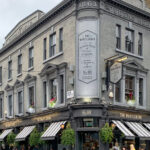The White Horse Tavern, nestled at 567 Hudson Street in the heart of Greenwich Village, New York City, isn’t just another bar. It’s a landmark drenched in history, a former haunt of literary giants, and a quintessential New York City experience. For generations, this no-fuss tavern has served as a meeting place, a watering hole, and a silent witness to the ebb and flow of city life. Its walls echo with tales of longshoremen, laborers, and some of the 20th century’s most celebrated writers.
A Dive Bar with Deep Roots in Greenwich Village
Established in 1880, the White Horse Tavern initially catered to the working class of the West Village. In the late 19th century, this area was a melting pot, largely populated by European immigrants. While other parts of Greenwich Village became known for their Italian communities, the area around the White Horse Tavern, close to the city’s first elevated train line, became a hub for Irish immigrants. It started as a longshoreman’s bar, providing a place for dockworkers to unwind after a hard day’s labor. This working-class origin imbued the tavern with a down-to-earth atmosphere that persists to this day, even amidst the changing landscape of Greenwich Village.
From Labor Hangout to Literary Landmark
The White Horse Tavern’s character evolved significantly in the mid-20th century. During the 1930s and 40s, it became a gathering spot for labor organizers, union members, and socialist thinkers. Groups like the Catholic Workers frequented the tavern, and legend has it that the seeds of the iconic Village Voice newspaper were sown within its walls. This period solidified its reputation as a place where ideas were exchanged and movements were born.
However, it was in the 1950s that the White Horse Tavern truly cemented its place in literary history. It became a bohemian haven, attracting renowned authors like William Styron and Norman Mailer. The proximity to New Directions Publishing, whose publisher James Laughlin had an office nearby, played a significant role. Visiting authors often found themselves drawn to the tavern’s unpretentious atmosphere.
Most famously, the White Horse Tavern is indelibly linked with Welsh poet Dylan Thomas. It is said to be the location where he drank his final whiskeys before his untimely death in New York City. His presence is still felt within the tavern, with his portrait prominently displayed near his favorite spot, serving as a poignant reminder of its literary legacy. Adding to the tavern’s lore, anecdotes abound about Jack Kerouac being repeatedly asked to leave, so frequently that someone famously etched “JACK GO HOME!” into a bathroom stall, a testament to the lively and sometimes rowdy literary scene that once thrived there.
More Than Just History: The Enduring Appeal
While its history is undoubtedly a major draw, the White Horse Tavern’s appeal extends beyond its famous patrons. It remains a classic New York City dive bar, offering a comforting sense of familiarity and unpretentious charm. The menu features simple, satisfying bar fare – from classic cheeseburgers and hot dogs to chili and sandwiches. It’s a place where you can grab a no-frills meal and a drink in an atmosphere steeped in history.
Designated a historic landmark in 1969, the White Horse Tavern has been preserved, at least in part, protecting its unique character for future generations. While the city around it has constantly evolved, the White Horse Tavern stands as a tangible link to a bygone era of Greenwich Village – a time when writers, artists, and thinkers gathered in unassuming spaces to shape culture and conversation. Visiting the White Horse Tavern today is more than just grabbing a drink; it’s stepping into a living piece of New York City history, a place where the echoes of literary legends still resonate.

